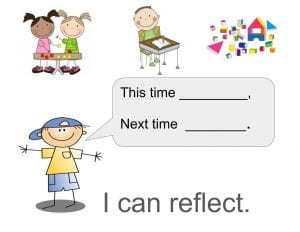“The definition of insanity is doing the same thing over and over and expecting different results.”
-Albert Einstein
During a morning meeting I attended this past week, teachers had the opportunity to share different approaches to how they have tried to implement the learner profile. Each person who shared, gave an example of what they had done last year, but then each elaborated on how they will approach it differently this year. As I listened, the thought came to mind that these teachers were sharing reflections, rather than just examples. By listening to what didn’t work, as well as each teachers’ new insights, we all had double the benefit.
“Reflective thinking turns experience into insight.” -John C. Maxwell
Reflection is the backbone to our learner profiles. A common question surrounding the Kaneland Learner Profile is, where do I find the time to teach my students to reflect? How can I add one more thing to teach in my school day? Other than a targeted lesson on what exactly reflection is, all other opportunities should be naturally embedded into our day. Reflective thinking is an opportunity for our learners to seek self awareness as well as improvement in the process and product of learning. Not only does reflection help our students learn, but when they share reflections with us, we can work more effectively to meet students’ needs.

I have spent time with kindergartners this past week who are learning the basics of reflection. They are using the framework “This time _____________, next time ____________” to think about their STEM projects. It is just a start, but will absolutely provide that language needed as we dig deeper into the quality of work across the curriculum. As our youngest learners begin learning this valuable skill, we are reminded that we all can find the insight from reflection.


In a fifth grade classroom, I witnessed fifth graders reflecting on their first experience using a learning pathway during science. Their reflections were so valuable in providing feedback to their peers, as well as their teacher, regarding this proficiency based format.
A few key points from an article outlining key components to reflective opportunities for your students:
- Provide enough wait-time for students to reflect when responding to inquiries.
- Provide emotionally supportive environments in the classroom encouraging reevaluation of conclusions.
- Prompt reviews of the learning situation, what is known, what is not yet known, and what has been learned.
- Provide authentic tasks involving ill-structured data to encourage reflective thinking during learning activities.
- Prompt students’ reflection by asking questions that seek reasons and evidence.
- Provide some explanations to guide students’ thought processes during explorations.
- Provide a less-structured learning environment that prompts students to explore what they think is important.
- Provide social-learning environments such as those inherent in peer-group works and small group activities to allow students to see other points of view.
- Provide reflective journal to write down students’ positions, give reasons to support what they think, show awareness of opposing positions and the weaknesses of their own positions.
The act of reflection will look very different in every classroom, considering not only the age difference that exists in our elementary setting, but also simply because reflection is very personal. However, it is a critical part of being a learner. It is something that requires modeling and practice. It can be used individually, but the the dialogue among students can make reflection a powerful learning experience for all.
Scaffolding Student Reflections Edutopia Article
Questions to prompt reflection before, during, and after learning